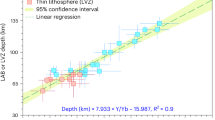Abstract
The isotope 138La makes up 0.089% of natural lanthanum and exhibits a branched decay, by β− to 138Ce and electron capture to 138Ba. The La–Ce isotope scheme is a potentially powerful adjunct to the Sm–Nd method for petrogenetic studies, but the best determination by counting of the β-decay half-life of La (3.02 x 1011 yr)1 is in conflict with geological half-life determinations based on La–Ce and Sm–Nd mineral isochrons2–4. To test these alternatives, I determined a six-point La–Ce isochron on whole-rock samples of Lewisian granulite-facies Archaean gneiss from NW Scotland. Here I report, based on a half-life of 3.02 × 1011yr, a La–Ce age of 2,990 ±400 Myr (2σ), which falls very well within the error of a whole-rock Sm–Nd date on Lewisian granulites of 2,895±100 Myr (2σ). This half-life (equivalent to a La β-decay constant of 2.30 × 10−12 yr-1) is therefore recommended for geological application of the Ce-isotope method.
This is a preview of subscription content, access via your institution
Access options
Subscribe to this journal
Receive 51 print issues and online access
$199.00 per year
only $3.90 per issue
Buy this article
- Purchase on Springer Link
- Instant access to full article PDF
Prices may be subject to local taxes which are calculated during checkout
Similar content being viewed by others
References
Sato, J. & Hirose, T. Radiochem. radioanalyt. Lett. 46, 145–152 (1981).
Tanaka, T. & Masuda, A. Nature 300, 515–518 (1982).
Tanaka, T. & Masuda, A. Nature 306, 504 (1983).
Shimizu, H. et al. Terra Cogn. 6, 145 (1986).
Norman, E. B. & Nelson, M. A. Phys. Rev. C27, 1321–1324 (1983).
Norman, E. B. & Nelson, M. A. Nature 306, 503–504 (1983).
Nakai, S. et al. Nature 320, 433–435 (1986).
Weaver, B. L. & Tarney, J. Earth planet. Sci. Lett. 51, 279–296 (1980).
Hamilton, P. J. et al. Nature 277, 25–28 (1979).
Hamilton, P. J. et al. Earth planet. Sci. Lett. 62, 263–272 (1983).
Chauvel, C. B. et al. Earth planet. Sci. Lett. 74, 315–324 (1985).
Taylor, P. N. et al. Geochim. cosmochim. Acta 44, 1437–1453 (1980).
Chapman, H. J. & Moorbath, S. Nature 268, 41–42 (1977).
Dickin, A. P. et al. Contr. Miner. Petr. (in the press).
Dickin, A. P. Nature (in the press).
York, D. Can. J. Phys. 44, 1079–1086 (1966).
Brooks, C. et al. Rev. Geophys. Space Phys. 10, 551–557 (1972).
Nakamura, N. Geochim. cosmochim. Acta 38, 757–775 (1974).
Author information
Authors and Affiliations
Rights and permissions
About this article
Cite this article
Dickin, A. La–Ce dating of Lewisian granulites to constrain the 138La β-decay half-life. Nature 325, 337–338 (1987). https://doi.org/10.1038/325337a0
Received:
Accepted:
Issue Date:
DOI: https://doi.org/10.1038/325337a0
This article is cited by
-
Ce and Nd isotope geochemistry on island arc volcanic rocks with negative Ce anomaly: existence of sources with concave REE patterns in the mantle beneath the Solomon and Bonin island arcs
Contributions to Mineralogy and Petrology (1992)
-
Mantle and crustal Ce/Nd isotope systematics
Nature (1988)
-
Mantle and crustal Ce/Nd isotope systematics
Nature (1988)
-
Cerium isotope geochemistry of ocean island basalts
Nature (1987)
-
A Ce/Nd isotope study of crustal contamination processes affecting Palaeocene magmas in Skye, Northwest Scotland
Contributions to Mineralogy and Petrology (1987)
Comments
By submitting a comment you agree to abide by our Terms and Community Guidelines. If you find something abusive or that does not comply with our terms or guidelines please flag it as inappropriate.



